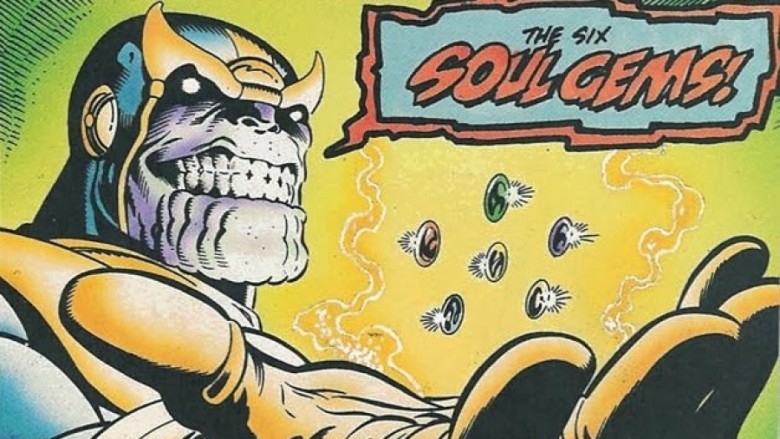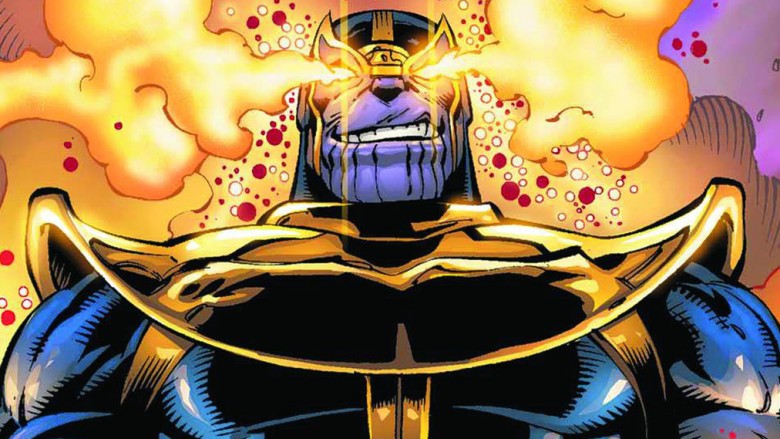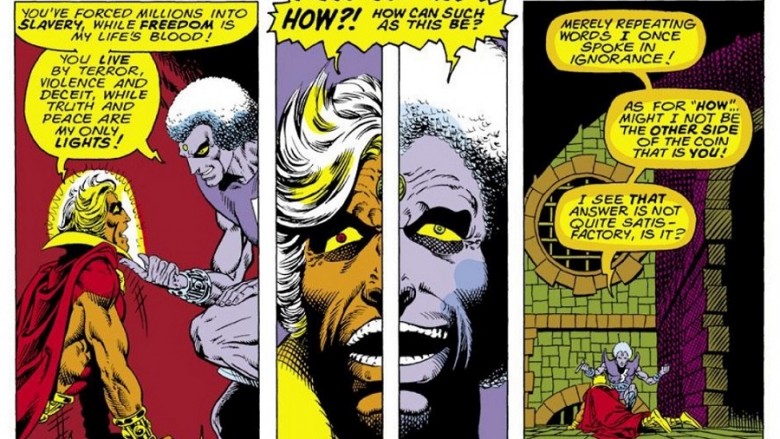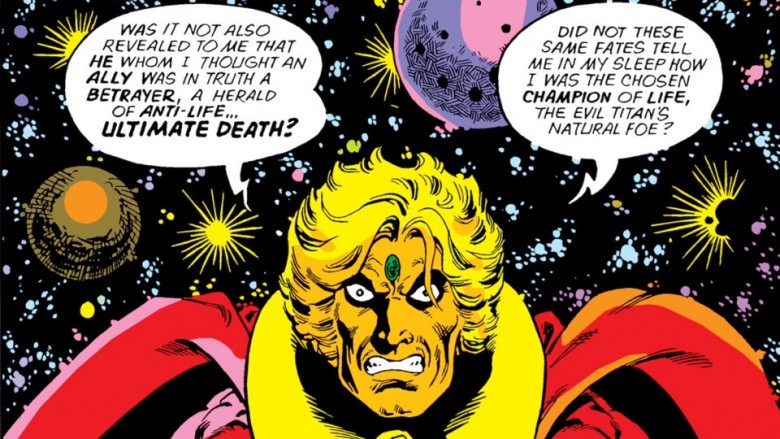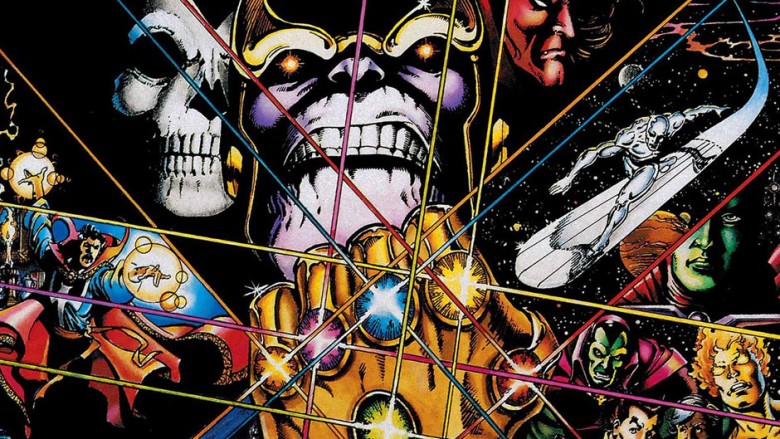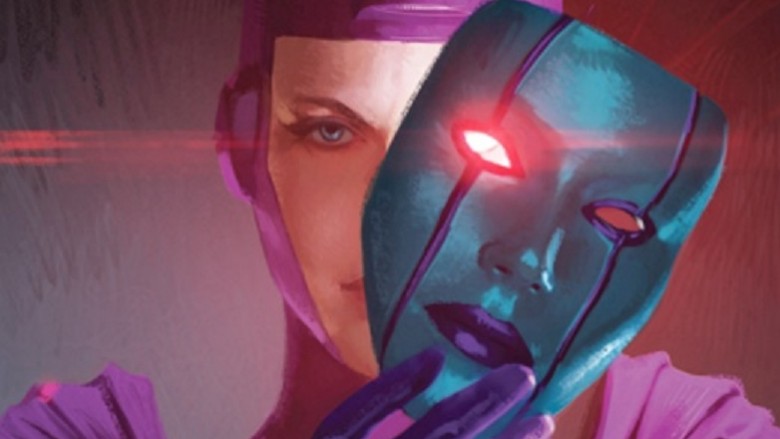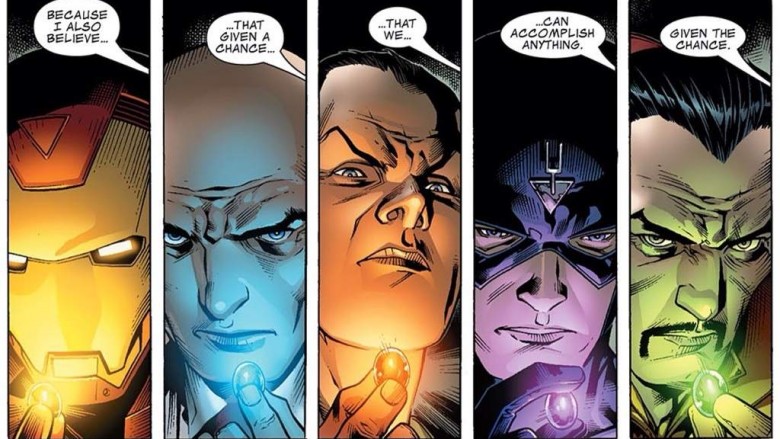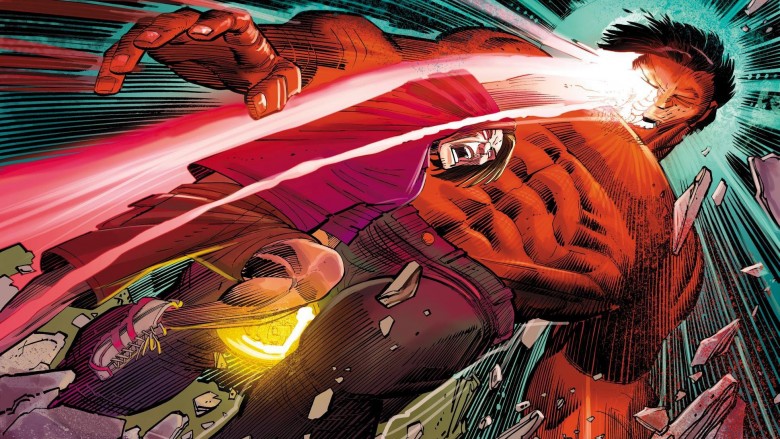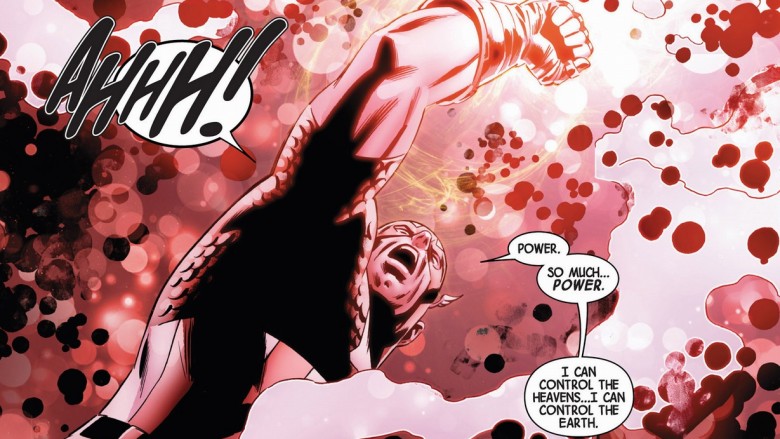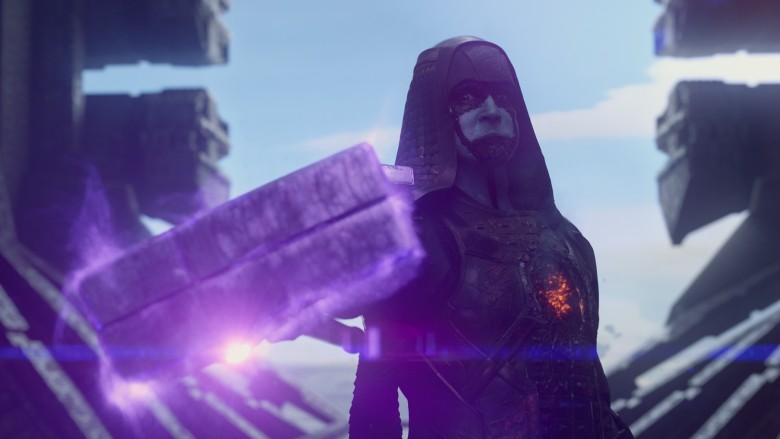The Untold Truth Of The Infinity Gems
Be warned. Major Marvel Cinematic Universe and old Marvel Comics spoilers lie ahead! The Infinity Stones (as they're called in the movies) and the Infinity Gems (as they've long been known in the comics) are otherworldly items that combine to give the powers of a god to whoever possesses them—usually by donning a glove known as the Infinity Gauntlet. As we all prepare our mortal minds for Avengers: Infinity War Part I's May 2018 arrival, we've rounded up some lesser-known facts about the history of these all-powerful baubles.
Originally called Soul Gems, they first appeared in 1972
Owing to the comics' flair for retroactive continuities, or retcons, the Infinity Gems have a convoluted history. Released in 1972, Marvel Premiere Vol. 1 #1 is known for introducing the green Soul Gem, the first of six such Gems identified in Avengers Annual #7 as the Soul Gems. Since a "Soul Soul Gem" would be ridiculous even by Marvel standards, the term Soul Gems fell out of use, and Infinity Gems became the accepted terminology. The other Soul Gems have five types, each with a corresponding color: Power (Red), Time (Orange), Reality (Yellow), Space (Purple), and Mind (Blue).
In Marvel Premiere Vol. 1 #1, Adam Warlock hatches from his human-sized cocoon to find himself on a ship disguised as an asteroid, thwarts the machinations of the evil Man-Beast, gets his Soul Gem when a godlike being called the High Evolutionary ceremoniously places the shining "emerald" on his forehead, and off he flies into space.
The "vampiric" Soul Gem's powers include the ability to manipulate, trap, and house souls. In fact, at various points in time (and space), it will house the souls of Pip the troll, Gamora, and Warlock himself, as well as the soul of Magus—Warlock's future evil self, a delirious religious zealot and founder of the diabolical Universal Church of Truth, along with the souls of several fallen enemies. The Soul Gem's power exceeds even Warlock's, and he struggles to control it. The thought of six of these incredibly powerful things together is horrifying.
Thanos renamed them the Infinity Gems after staring into the Infinity Well
In the Marvel Cinematic Universe, Thanos is, thus far, an imposing purple monster with an affinity for wearing shiny gloves, grumbling, making pouty faces as he sits on his floating throne, and abruptly ending video chats with Ronin the Accuser. Compared to the godlike terror of his namesake in the comics, this live-action Thanos seems temperamental, old, tired, and bored.
If all you know of "the mad Titan" is from Josh Brolin's cameos in Marvel movies, then you're missing out on one hella weird backstory. Even without the god-making Infinity Gauntlet—the glove from Avengers: Age of Ultron's mid-credits sequence—Thanos is one very bad guy. He can take on the entire Avengers lineup and win the fight. Capable of putting down the Hulk without breaking a sweat, Thanos is a monster Drax the Destroyer once described as "the Devil himself."
Thanos first appeared in Iron Man #55 in February 1973. "Influenced" by DC's New Gods, his first appearance more closely resembled the scrawny Metron before editors suggested his signature musclebound, Darkseidesque look. Created by Jim Starlin and Mike Friedrich, Thanos is, by far, the evildoer most often associated the Infinity Gems. An Eternal born with the "Deviant Syndrome," he's a monstrous, Lady Death-obsessed alien from Titan, hellbent on bringing about the destruction of the universe for his own absurd ends. Thanos spends much of his time looking into the mysterious Infinity Well, which acts as a cosmic GPS for the Infinity Gems.
According to the accepted retcon of Thanos's timeline, his father, A'Lars (called by his alias, "Mentor," in Iron Man #55), and his mother Sui-San (identified by name in Captain Marvel #29) are Eternals who inhabit a peaceful, weaponless, computer-directed, utopian society beneath the surface of the Saturnian moon Titan. Obsessed with death, Thanos destroys the utopian society. Somehow, his non-Deviant brother Eros—who will later become Starfox—and their father escape the doomed moon; Thanos's mother does not.
Avengers: Infinity War will introduce Adam Warlock's evil double Magus
From the Vision and Scarlet Witch's unmarried state (and all-new backstories) to Black Widow's conspicuously absent Russian accent, the Marvel Cinematic Universe's deviations from the comics have been numerous. While most of the changes have worked surprisingly well, the omission of Adam Warlock from the narrative has been puzzling.
Naturally, fans of the comics freaked when they saw a human-sized cocoon on the Collector's ship in Thor: The Dark World's credit sequence, and later in Guardians of the Galaxy. Finally, the MCU would address its most glaring omission—or so it seemed. As quickly as the fan service was paid, the Collector and his collection exploded into a bajillion pieces. We don't know whether Warlock will make an appearance in Avengers: Infinity War Part 1, but his evil alter ego, the Magus, was reportedly featured in a casting call. Here's hoping the rumors turn out to be true.
Adam Warlock is essential to understanding the Infinity Gems
To better understand the Infinity Gems, we need to go deeper into Adam Warlock's pre-Soul Gem backstory. Breaking from his cocoon in the High Evolutionary's asteroid-like spaceship, Warlock—still known as "Him" at the time—was reborn. Aside from Warlock and Thanos, others who've possessed the gems include the Supreme Intelligence of the Kree Empire, the Silver Surfer, the Elders of the Universe, Doctor Strange, and, in one contingency, even Captain America.
In 1973's Strange Tales #178, writer Jim Starlin—speaking through the fourth-wall-breaking alien Sphinxor from the star system Pegasis—sums up Warlock's origin story, originally told in Fantastic Four #66-67, Thor #165-166, Marvel Premiere #1-2, Warlock #1-8 and Hulk #176-178. According to Strange Tales #178's simplified chronology, a group of scientists (his "fathers") are cooking up the "perfect man of the future" in a "super-sophisticated research lab known as the Bee Hive," located somewhere on Earth. There, he breaks out of his first cocoon—which Sphinxor calls Warlock's "mother." Warlock uses his "power to see into men's souls" on his "fathers." None too pleased with their evil plan, Warlock smashes up the Bee Hive and goes out into space.
Warlock's origin story then takes a dark turn when our would-be hero turns into a would-be rapist. Lonely for a "mate," soon-to-be Warlock, presently Soul-Gemless Him, tries to abduct Sif. Identified as "Thor's girlfriend" in Strange Tales #178, Sif is a fearsome warrior goddess in her own right. She could easily fend off the aggressor on her own. As it happens, though, Thor flies to her aid and beats the living daylights out of Him, who subsequently makes himself another cocoon in which to recover and "meditate on his, up to now, useless existence."
That's when, chronologically, the cocoon encounters the High Evolutionary's spaceship disguised as an asteroid, and the events of Marvel Premiere Vol 1 #1 unfold, beginning with Warlock's rebirth and culminating in his christening with the Soul Gem that will be his blessing and his curse. Given his repulsive, uncivilized beginnings and future transformation into the Magus, it's shocking that Adam Warlock is also the universe's last hope against the tyranny of the Infinity Gems. All he has to do first is die, spiritually inhabit the Soul Gem, and be transformed by the community of "love" and oneness therein, as we see in the beautiful, far-out ending of Avengers Annual #7, in which Warlock finds peace and "love" among his fallen friends and foes inside the Soul Gem.
The Gems transcend spacetime, universes, and planes of existence
In creator Jim Starlin's words, Thanos's storylines are "more metaphysical, more acid-trippy," than a typical supervillain's. Prime examples of Thanos's psychedelic storylines include his mindbending pursuit of the Cosmic Cube in Captain Marvel and, of course, his transdimensional quest to find the Infinity Gems for his Infinity Gauntlet, chronicled in The Thanos Quest and The Infinity Gauntlet.
In The Thanos Quest, Thanos crosses dimensions of time and space on his quest to collect the Gems, encountering the Elders of the Universe and the Champion. The Infinity Gems aren't necessarily beholden to the laws of physics in our universe. In The Infinity Gauntlet, Thanos comes much too close to destroying the entire universe—including time and space—with the help of the Infinity Gems. Don't think too much about the logistics of moving solid objects between dimensions of space, time, and reality. It's superhero comics. Not making sense is part of the fun—when it's done right. It gets even wilder in The Infinity Gauntlet.
The Infinity Gems storylines reveal Thanos's reality-fracturing hopeless romantic side
If you haven't read it and you must know right now, the events of The Infinity Gauntlet have been summarized by Marvel TL;DR in the video above. However, in this case, we recommend reading the comic. It's a mind-bending story of cosmic struggle that's really worth your time.
Widely regarded as Jim Starlin's Thanos-related masterpiece, The Infinity Gauntlet is a six-part series which continues the chronology of The Thanos Quest. Thanos is the most unlikely hopeless romantic. With his many awesome powers, why does he feel compelled to devote himself to a lover who ignores and will not have him? Such are the mysteries of the human and/or undying extraterrestrial heart! In the comics, he spends his criminal career trying to acquire godlike abilities through various means, in a stubborn effort to impress and woo Lady Death. Time and again, Thanos's obsession with Death turns out to be one-sided. She can't stand him.
Will the MCU will explore Thanos's emotional turmoil and addiction to self-sabotage? Time will tell!
Kang's Dark Ultimates time-traveled to get ahold of the Infinity Gems
Something is missing when the story becomes about an ultra-jingoistic spin on Captain America (he hates the French—why?), an angsty alcoholic Iron Man (think Robert Downey, Jr.'s MCU Iron Man without the charm or the one-liners), and Norse gods who think farting is funny (seriously)—or so runs the general consensus about Earth-1610's "Ultimate" take on the Avengers. It's even worse when the good guys get replaced by bad versions of themselves. That's what happened with the Dark Ultimates.
The Dark Ultimates aren't discussed much. They're part of the Earth-1610 universe of Ultimate Marvel (later Ultimate Comics). Envisioned as a sort of PG-13 middle ground between the kindly classics and the ultra-gritty stuff that would later appear in 2001's adults-only Marvel MAX universe, Ultimate Marvel launched in 2000, with an emphasis on realism and accessibility. Once promising, the Ultimate universe turned into quite the mess in its 15-year run. It was all resolved by the Secret Wars event in 2015, but not before a lackluster return to the Infinity Gauntlet trope.
This time it was Kang (evil Susan Storm), a mysterious woman who destroyed the Triskelion (S.H.I.E.L.D. headquarters), freed Bruce Banner and Reed Richards (for nefarious ends, naturally), and sought to collect not only the six gems but a seventh as well. (The seventh was located in Iron Man's brain, because that totally makes sense.) The whole kerfuffle winds up with Reed Richards imprisoned in the Cube, Kang time-traveling again, and Iron Man's human consciousness being digitally preserved.
Each member of the Illuminati took a gem and hid it from the others
In the New Avengers: Illuminati, Mr. Fantastic has acquired the Power Gem from She-Hulk. He brings it to a meeting of the Illuminati, a secret club of superheroes whose ranks also include Dr. Strange, Iron Man, Namor, Black Bolt, and Professor Charles Xavier. Black Panther sometimes sits in on meetings too.
In the meeting, Mr. Fantastic reveals he has been collecting Infinity Gems and he has the Infinity Gauntlet. These revelations don't go over very well. With three Gems in his possession, Richards suggests they collect the other three and destroy them. He has a bit of a grudge against them since, during the events of The Infinity Gauntlet, he "ceased to exist." (Thanks for that, Thanos!) The Illuminati reluctantly agree to help.
More revelations follow: the gems talk to each other. The Time gem is unstuck and "adrift in time." The Reality gem sits "at the edge of reality." The Mind gem is the Collective Unconscious of the universe. They plan to acquire the Mind and Reality gems simultaneously, thus luring the Time gem into existence. (Don't ask. While Brian Michael Bendis and Brian Reed's explanation-heavy story does a pretty good job of making the characters distinct, it lacks Starlin's trippy symbolic finesse.) Ultimately, once the Illuminati have the gems, Richards hopes to will the gems out of existence. When this fails, the Watcher intervenes and they each take a gem and hide it from the others, in the hope that the gems will never be brought together again.
Yeah, right.
After Siege of Asgard, the Hood sought to collect the Infinity Gems
Siege is an epic event about the hubris of Marvel supervillain Norman Osborn and his plan to invade Asgard. (Yes, Asgard.) Its scope is too big for us to do justice to it here, but following its events, the Hood is locked up in prison. As he plots his escape—and Infinity Gem-enabled revenge—the Illuminati's secret identities are compromised to the other Avengers, who are none too happy to learn about the secret world-saving, Infinity-Gem-hiding club they were never invited to join.
In Avengers Vol 4 #11, the Hood's quest for the final Infinity Gem leads him to the astral plane, where he runs into none other than Thanos, who barters with him for the gems. The Hood can turn over the gems to Thanos (and trust that Thanos will grant him the power he seeks) or he can try to wield the gems' power—a trick no human has ever pulled off—and, as a result, "cease to be." (Thanos bartering with...mortals?) When the Hood refuses the offer, the ruse is revealed: "Thanos" isn't Thanos. He's Doctor Strange, up to his magic tricks again—because, apparently, impersonating the Mad Titan himself is something he can do in the astral plane.
The story arc ends with the Hood back in a cell and Iron Man wearing the Gauntlet—wait, Iron Man can wear the Infinity Gauntlet now?—and pretending to will the gems out of existence. Later, the Illuminati plus Captain America hide the gems again, having learned nothing from the whole stupid adventure.
Captain America owes us five Infinity Gems (because he broke 'em saving the world)
In New Avengers Vol 3 #3 during the dreaded universe-melding Marvel NOW event, incursions—chain reactions of colliding and collapsing universes—threaten all things in all planes of existence. The Illuminati fetch the hidden gems and assemble the Gauntlet, agreeing that Captain America should be the one to wield it. (The Illuminati storylines feel like a bad comedy of errors at times, with the club meeting up either to hide the Gems or to go find them again.) Captain America uses the Gauntlet to stop the Earth from being destroyed, but the five gems shatter and the Time Gem dissolves. This is why the Ultimates get a bad rap: no human can wield the gems—except a wealthy alcoholic with expensive toys and now this idiot.
Ronan the Accuser's connection is more complicated and indirect in the comics
In the Guardians of the Galaxy movie, Ronan the Accuser, a member of the Kree, seizes control of an Infinity Stone and wields its power. This has never happened in the comics—because it couldn't. Ronan would've been destroyed by an Infinity Gem's power as he grabbed hold of it.
Although the movies merely touch on it, the Kree Empire's connection to the Infinity Gems runs deep in the comics. As shown via flashback in Captain Marvel Vol 1 #38, there is a rich history among the so-called First Kree (a war-loving civilization of blue-skinned humanoids), the Cotati (plant people), and the Skrulls (once-peaceful reptilian spacefarers, now war-crazed Deviants, thanks to the Kree's influence). The Skrulls pitted members of the Kree against members of the Cotati in a contest on Earth's moon to see which civilization was better. When the Skrulls chose the Cotati's garden over the Kree's city, the Kree killed them both and stole the Skrulls' space technology. Nice guys, those Kree.
During the Kree civilization's encounter with the Infinity Gems in the comics, Ronan played second fiddle to the Supreme Intelligence, the Kree's supercomputer of hivemind consciousness. When a great Kree dies, his or her mind is absorbed into the Supreme Intelligence. Thus, the Supreme Intelligence is much closer to a god and much better equipped to wield the gems than Ronan. That's not to say Ronan isn't a badass in the comics. His hammer, called the Universal Weapon, can twist matter and teleport him wherever he wishes. Plus his blue skin—a sign of genetic purity among the Kree—gives him aristocratic status. But his power pales in comparison to that of godlike beings such as the Supreme Intelligence and Thanos, let alone the freakin' god-making Infinity Gems.

